Sherwood R-904N OPERATING INSTRUCTIONS

 cover_904N:cover_904N 2009-10-15 11:53 1
cover_904N:cover_904N 2009-10-15 11:53 1
R-904N
NetBoxx

 R-904N(A)_ENG_091007:R-904N(A) 2009-10-14 1:53
R-904N(A)_ENG_091007:R-904N(A) 2009-10-14 1:53  2
2
ENGLISH
IMPORTANT SAFETY INSTRUCTIONS
1.Read these instructions.
2.Keep these instructions.
3.Heed all warnings.
4.Follow all instructions.
5.Do not use this apparatus near water.
6.Clean only with dry cloth.
7.Do not block any ventilation openings.
Install in accordance with the manufacturer’s instructions.
8.Do not install near any heat sources such as radiators, heat registers, stoves, or other apparatus (including amplifiers) that produce heat.
9.Do not defeat the safety purpose of the polarized or grounding-type plug. A polarized plug has two blades with one wider than the other.
A grounding type plug has two blades and a third grounding prong. The wide blade or the third prong are provided for your safety. If the provided plug does not fit into your outlet, consult an electrician for replacement of the obsolete outlet.
10.Protect the power cord from being walked on or pinched particularly at plugs, convenience receptacles, and the point where they exit from the apparatus.
11.Only use attachments accessories specified by the manufacturer.
12.Use only with the cart, stand, tripod, bracket, or table specified by the manufacturer, or sold with the apparatus.
When a cart is used, use caution when moving the cart/apparatus combination to avoid injury from tip-over.
PORTABLE CART WARNING
13.Unplug this apparatus during lightning storms or when unused for long periods of time.
14.Refer all servicing to qualified service personnel. Servicing is required when the apparatus has been damaged in any way, such as power-supply cord or plug is damaged, liquid has been spilled or objects have fallen into the apparatus, the apparatus have been exposed to rain or moisture, does not operate normally, or has been dropped.
2

 R-904N(A)_ENG_091007:R-904N(A) 2009-10-14 1:53
R-904N(A)_ENG_091007:R-904N(A) 2009-10-14 1:53  3
3
Introduction
READ THIS BEFORE OPERATING YOUR UNIT
|
|
|
|
This symbol is intended to alert the user to the presence of |
|
|
|
|
uninsulated “dangerous voltage” within the product's |
|
|
|
|
enclosure that may be of sufficient magnitude to constitute |
|
|
|
|
a risk of electric shock to persons. |
CAUTION |
: TO REDUCE THE RISK OF ELECTRIC |
|
|
|
|
|
|
||
|
|
This symbol is intended to alert the user to the presence of |
||
SHOCK, DO NOT REMOVE COVER (OR |
|
|
||
|
BACK). NO USER-SERVICEABLE PARTS |
|
|
important operating and maintenance (servicing) |
|
INSIDE. REFER SERVICING TO |
|
|
instructions in the literature accompanying the appliance. |
|
QUALIFIED SERVICE PERSONNEL. |
|
|
|
|
|
|
|
|
WARNING : TO REDUCE THE RISk OF FIRE OR ELECTRIC SHOCk,
DO NOT ExPOSE THIS APPLIANCE TO RAIN OR MOISTURE.
Caution regarding installation
Note : For heat dispersal, do not install this unit in a confined space such as a bookcase or similar enclosure.
Do not block ventilation openings or stack other equipment on the top.
Note to CATV System Installer :
This reminder is provided to call the CATV system installer’s attention to Article 820-40 of the NEC that provides guidelines for proper grounding and, in particular, specifies that the cable ground shall be connected to the grounding system of the building, as close to the point of cable entry as practical.
FCC INFORMATION
This equipment has been tested and found to comply with the limits for a Class B digital device, pursuant to Part 15 of the FCC Rules. These limits are designed to provide reasonable protection against harmful interference in a residential installation. This equipment generates, uses and can radiate radio frequency energy and, if not installed and used in accordance with the instructions, may cause harmful interference to radio communications. However, there is no guarantee that interference will not occur in a particular installation. If this equipment does cause harmful interference to radio or television reception, which can be determined by turning the equipment off and on, the user is encouraged to try to correct the interference by one or more of the following measures:
•Reorient or relocate the receiving antenna.
•Increase the separation between the equipment and receiver.
•Connect the equipment into an outlet on a circuit different from that to which the receiver is connected.
•Consult the dealer or an experienced radio/TV technician for help.
Caution : Any changes or modifications in construction of this device which are not expressly approved by the party responsible for compliance could void the user’s authority to operate the equipment.
This Class B digital apparatus complies with Canadian ICES-003.
Cet appareil numérique de la Classe B est conforme à la norme NMB-003 du Canada.
FOR YOUR SAFETY
U.S.A
120 V
CANADA
Units shipped to the U.S.A and CANADA are designed for operation on 120 V AC only.
Safety precaution with use of a polarized AC plug.
However, some products may be supplied with a nonpolarized plug.
CAUTION : To prevent electric shock, match wide blade of plug to wide slot, fully insert.
ATTENTION : Pour éviter chocs électriques, introduire la lame la plus large de la fiche dans la borne
correspondante de la prise et pousser jusqu’ au fond.
ENERGY STAR® is a U.S. registered mark. As an ENERGY STAR® Partner, Sherwood has determined that this product meets the ENERGY STAR® guidelines for energy efficiency.
CAUTION
• Leave a space around the unit for sufficient ventilation.
• Avoid installation in extremely hot or cold locations, or in an area that is exposed to direct sunlight or heating equipment.
• Keep the unit free from moisture, water, and dust.
• Do not let foreign objects in the unit.
• The ventilation should not be impeded by covering the ventilation openings with items, such as newspapers, table-cloths, curtains, etc.
• No naked flame sources, such as lighted candles, should be placed on the unit.
• Please be care the environmental aspects of battery disposal.
• The unit shall not be exposed to dripping or splashing for use.
• No objects filled with liquids, such as vases, shall be placed on the unit.
• Do not let insecticides, benzene, and thinner come in contact with the set.
• Never disassemble or modify the unit in any way. ■Notes on the AC power cord and the wall outlet.
•The unit is not disconnected from the AC power source(mains) as long as it is connected to the wall outlet, even if the unit has been turned off.
•To completely disconnect this product from the mains, disconnect the plug from the wall socket outlet.
•When setting up this product, make sure that the AC outlet you are using is easily acceptable.
•Disconnect the plug from the wall outlet when not using the unit for long periods of time.
ENGLISH
3
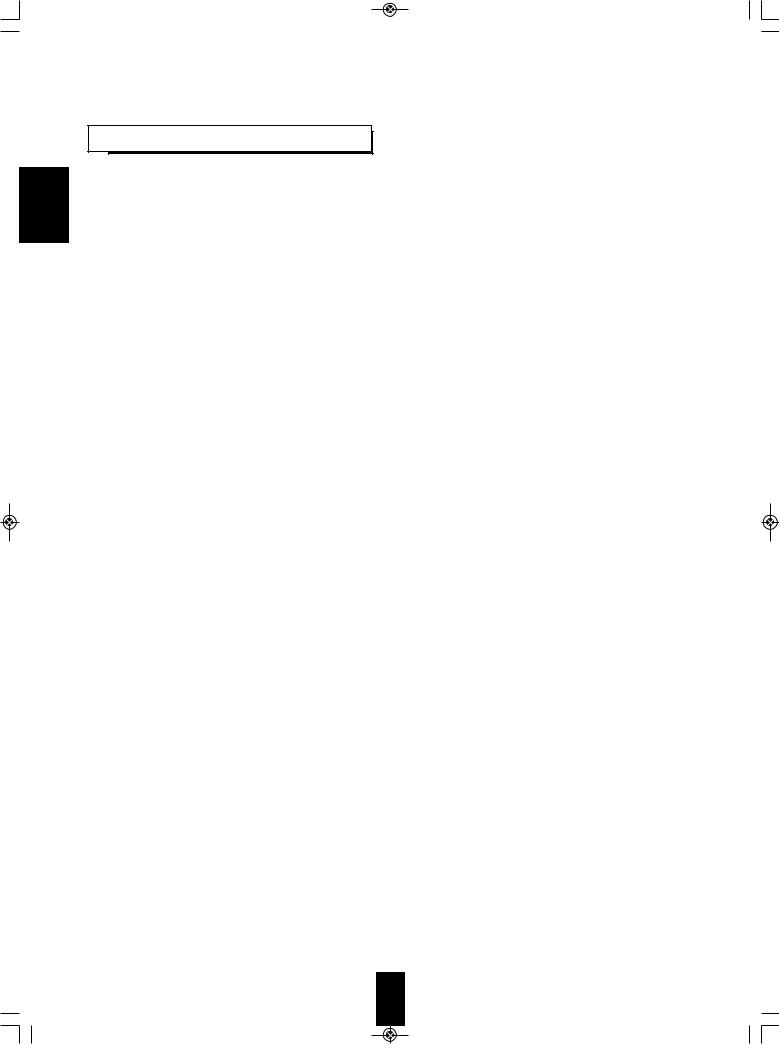
 R-904N(A)_ENG_091007:R-904N(A) 2009-10-14 1:53
R-904N(A)_ENG_091007:R-904N(A) 2009-10-14 1:53  4
4
ENGLISH
contents
• IMPORTANT SAFETY INSTRUCTIONS . . . . . . . . . . . . . . . . . . . . . . . . . . . . . . . . . . . . . . . . . . . . . . . . . . . . . . 2
• Introduction
READ THIS BEFORE OPERATING YOUR UNIT . . . . . . . . . . . . . . . . . . . . . . . . . . . . . . . . . . . . . . . . . . . . 3
• System Connections . . . . . . . . . . . . . . . . . . . . . . . . . . . . . . . . . . . . . . . . . . . . . . . . . . . . . . . . . . . . . . . . . . . . 5
• Front Panel Controls . . . . . . . . . . . . . . . . . . . . . . . . . . . . . . . . . . . . . . . . . . . . . . . . . . . . . . . . . . . . . . . . . . . 11
• Universal Remote Controls . . . . . . . . . . . . . . . . . . . . . . . . . . . . . . . . . . . . . . . . . . . . . . . . . . . . . . . . . . . . . . 13
OPERATING COMPONENTS WITH REMOTE CONTROL . . . . . . . . . . . . . . . . . . . . . . . . . . . . . . . . . . . 15
REMOTE CONTROL OPERATION RANGE . . . . . . . . . . . . . . . . . . . . . . . . . . . . . . . . . . . . . . . . . . . . . . . 15
LOADING BATTERIES . . . . . . . . . . . . . . . . . . . . . . . . . . . . . . . . . . . . . . . . . . . . . . . . . . . . . . . . . . . . . . . 15
USING FUNCTIONS OF REMOTE CONTROL . . . . . . . . . . . . . . . . . . . . . . . . . . . . . . . . . . . . . . . . . . . . . 16
• Operations
LISTENING TO A PROGRAM SOURCE . . . . . . . . . . . . . . . . . . . . . . . . . . . . . . . . . . . . . . . . . . . . . . . . . . 19
SURROUND SOUND . . . . . . . . . . . . . . . . . . . . . . . . . . . . . . . . . . . . . . . . . . . . . . . . . . . . . . . . . . . . . . . . 21
ENJOYING SURROUND SOUND . . . . . . . . . . . . . . . . . . . . . . . . . . . . . . . . . . . . . . . . . . . . . . . . . . . . . . . 23
LISTENING TO RADIO BROADCASTS . . . . . . . . . . . . . . . . . . . . . . . . . . . . . . . . . . . . . . . . . . . . . . . . . . 28
ABOUT VuNow Pod . . . . . . . . . . . . . . . . . . . . . . . . . . . . . . . . . . . . . . . . . . . . . . . . . . . . . . . . . . . . . . . . . . 30
ENJOYING INTERNET VIDEOS . . . . . . . . . . . . . . . . . . . . . . . . . . . . . . . . . . . . . . . . . . . . . . . . . . . . . . . . 31
OTHER FUNCTIONS . . . . . . . . . . . . . . . . . . . . . . . . . . . . . . . . . . . . . . . . . . . . . . . . . . . . . . . . . . . . . . . . . 44
ROOM2 SOURCE PLAYBACK . . . . . . . . . . . . . . . . . . . . . . . . . . . . . . . . . . . . . . . . . . . . . . . . . . . . . . . . . 45
• System Setup . . . . . . . . . . . . . . . . . . . . . . . . . . . . . . . . . . . . . . . . . . . . . . . . . . . . . . . . . . . . . . . . . . . . . . . . . 46
SETTING THE SYSTEM . . . . . . . . . . . . . . . . . . . . . . . . . . . . . . . . . . . . . . . . . . . . . . . . . . . . . . . . . . . . . . 48
SETTING THE ROOM EQ . . . . . . . . . . . . . . . . . . . . . . . . . . . . . . . . . . . . . . . . . . . . . . . . . . . . . . . . . . . . . 49
SETTING THE SPEAKER SETUP . . . . . . . . . . . . . . . . . . . . . . . . . . . . . . . . . . . . . . . . . . . . . . . . . . . . . . 50
SETTING THE MULTI ROOM SETUP . . . . . . . . . . . . . . . . . . . . . . . . . . . . . . . . . . . . . . . . . . . . . . . . . . . 54
• Troubleshooting Guide . . . . . . . . . . . . . . . . . . . . . . . . . . . . . . . . . . . . . . . . . . . . . . . . . . . . . . . . . . . . . . . . . 55
• Specifications . . . . . . . . . . . . . . . . . . . . . . . . . . . . . . . . . . . . . . . . . . . . . . . . . . . . . . . . . . . . . . . . . . . . . . . . . 56
• Setup Code Table . . . . . . . . . . . . . . . . . . . . . . . . . . . . . . . . . . . . . . . . . . . . . . . . . . . . . . . . . . . . . . . . . . . . . . 57
4
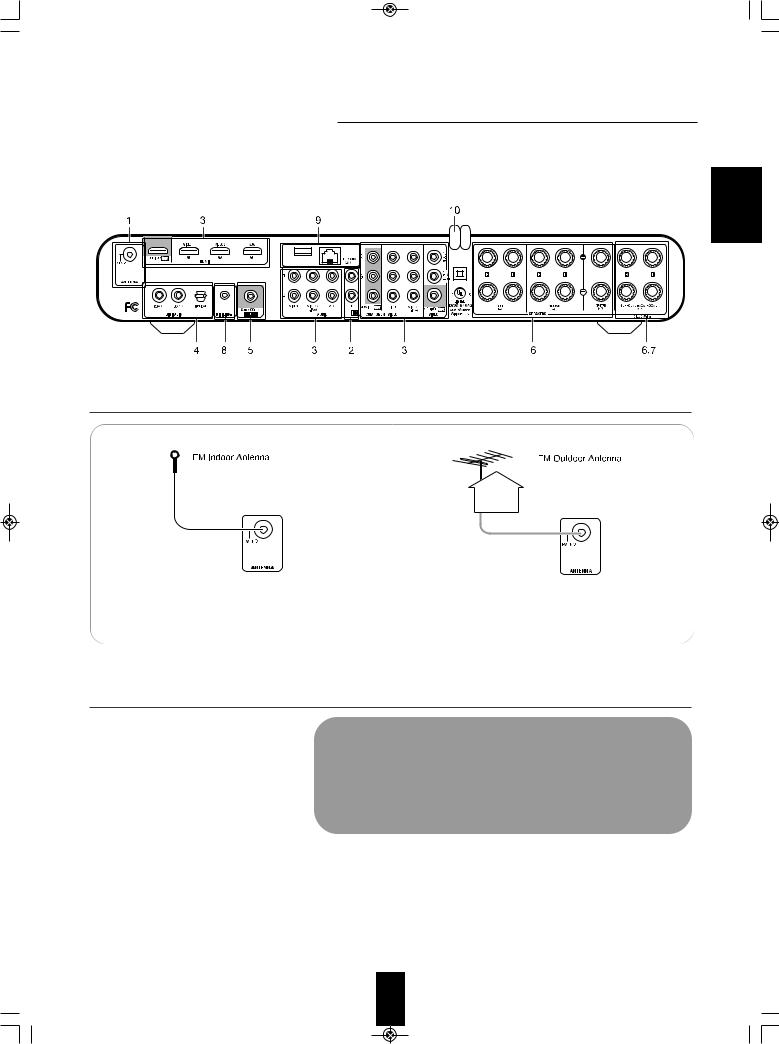
 R-904N(A)_ENG_091007:R-904N(A) 2009-10-14 1:53
R-904N(A)_ENG_091007:R-904N(A) 2009-10-14 1:53  5
5
System Connections
• Please be certain that this unit is unplugged from the AC outlet before making any connections. |
|
|
• Since different components often have different terminal names, carefully read the operating instructions of the component |
|
|
connected. |
|
|
• Be sure to observe the color coding when connecting audio, video and speaker cords. |
ENGLISH |
|
• Make connections firmly and correctly. If not, it can cause loss of sound, noise or damage to the receiver. |
||
|
1. CONNECTING ANTENNAS
•Change the position of the FM indoor antenna until you get the best reception of your favorite FM stations.
•A 75Ω outdoor FM antenna may be used to further improve the reception. Disconnect the indoor antenna before replacing it with the outdoor one.
2. CONNECTING AUDIO COMPONENT
•The CD IN jacks can be connected to a CD player, tape deck, etc.
5
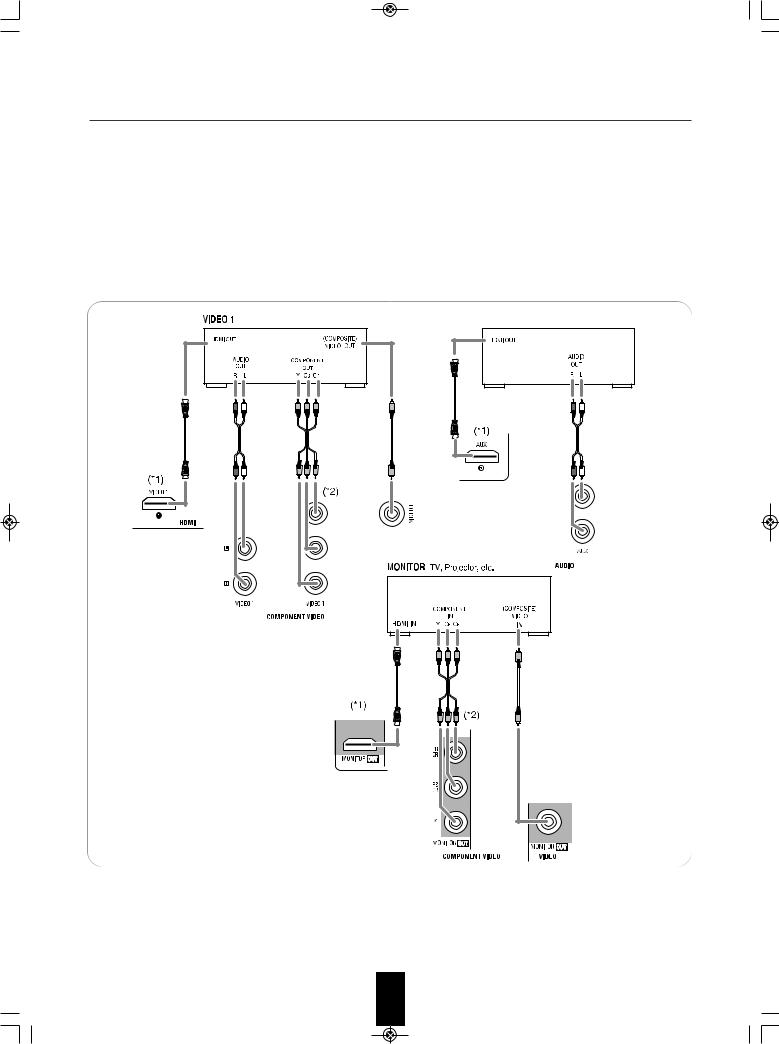
 R-904N(A)_ENG_091007:R-904N(A) 2009-10-14 1:53
R-904N(A)_ENG_091007:R-904N(A) 2009-10-14 1:53  6
6
3. CONNECTING VIDEO COMPONENTS
|
• The jacks of VIDEO 1/VIDEO 2 can be connected to a BD player, DVD player, cable TV tuner, satellite system, etc. |
|
|
• Connect the jacks of VIDEO 2 to the video component in the same way. |
|
|
• The jacks of AUX can be connected to an additional video component without analog video jacks. |
|
ENGLISH |
The AUDIO jacks of AUX can be also connected to an additional audio component such as a CD player, tape deck, etc. |
|
• There are two types of video jacks (COMPONENT, (composite) VIDEO) for analog video connections and the HDMI |
||
|
||
|
connectors for digital video and audio connections. |
|
|
Connect them to the corresponding video jacks according to their capability. |
|
|
• For your reference, the excellence in picture quality is as follows : “HDMI” > “COMPONENT” > “(composite) VIDEO” . |
|
|
• When making COMPONENT VIDEO connections, connect “Y” to “Y”, “PB/CB” to “CB”(or “B-Y”, “PB”) and “PR/CR” to “CR”(or |
|
|
||
|
“R-Y”, “PR”). |
|
|
• When viewing video program sources through MONITOR OUT jack, you must use the same type of video jacks that you did |
|
|
connect to video playback components such as BD player, DVD player, cable TV tuner, etc. |
BD player, DVD player, etc.
AUX BD player, Video game player, etc.
■Notes :
•You can connect Apple iPod to this receiver via Sherwood iPod dock. If Sherwood iPod dock is connected to DIGILINK-i jack for system control, you should connect its video and audio jacks to the “VIDEO 2” jacks of this receiver. Because, when you control your iPod with the unit's remote control, the VIDEO 2/iPod is automatically selected as an input source and the corresponding operation is performed.
•You can enjoy viewing internet video contents that the VuNow Pod delivers via either the HDMI (given priority) or the
(composite) VIDEO MONITOR OUT only, not the COMPONENT MONITOR OUTs.
6
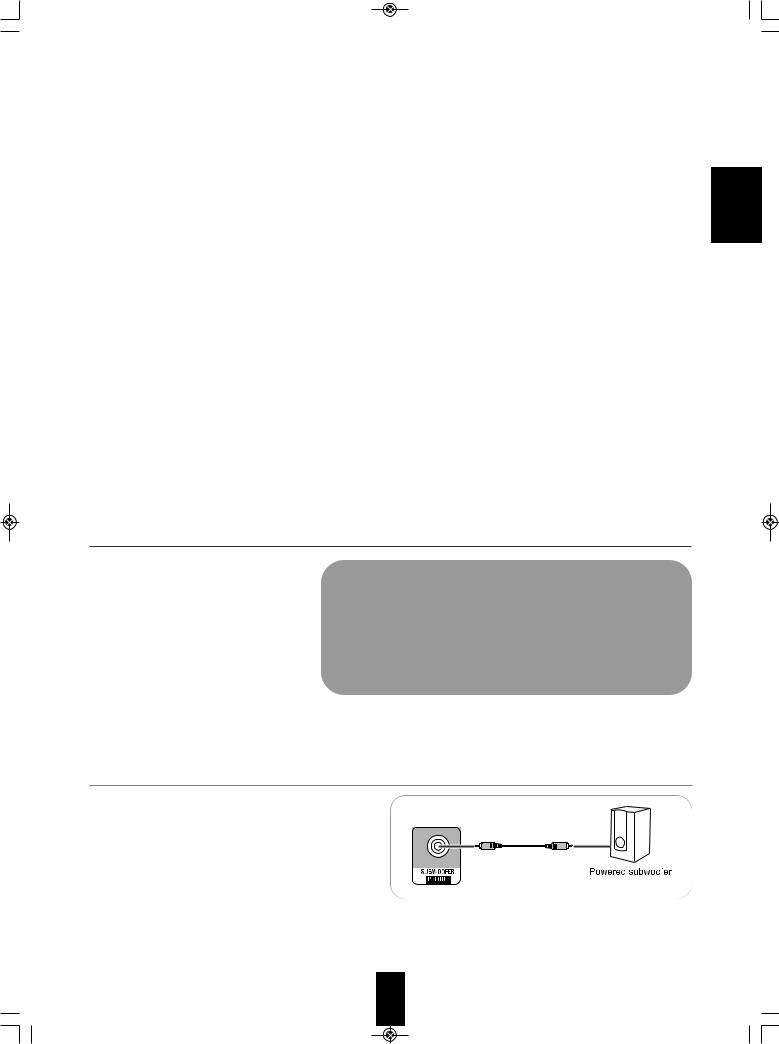
 R-904N(A)_ENG_091007:R-904N(A) 2009-10-14 1:53
R-904N(A)_ENG_091007:R-904N(A) 2009-10-14 1:53  7
7
Continued
■HDMI (High Definition Multimedia Interface) connection : (*1)
•You can connect the source component (BD player, etc.) to the display component (TV, projector, etc.) through this receiver with using a commercially available HDMI cord.
•The HDMI connection can carry uncompressed digital video signals and digital audio signals.
•The HDMI video stream signals (video signals) are theoretically compatible with DVI-D. When connecting to a TV monitor, etc., equipped with DVI-D connector, it is possible to connect using a commercially available HDMI-DVI converter cord. Since the HDMI-to-DVI connection cannot carry any audio signals, set the “HDMI” to “AMP” to hear the HDMI digital audio signals on this receiver. (For details, refer to the “When selecting the “HDMI (HDMI Audio Out)” on page 25.)
■Copyright protection system
•This unit supports HDCP (High-bandwidth Digital Contents Protection), technology to protect copyright of digital video signals against illegal duplication. HDCP must also be supported on the components connected to this unit.
•This unit is HDMI Ver. 1.3 compatible.
•HDMI, the HDMI logo and High-Definition Multimedia Interface are trademarks or registered trademarks of HDMI licensing LLC.
■Notes :
•For stable signal transfer, we recommend using HDMI cords that are a maximum of 5 meters in length.
•Among the components that support HDMI, some components can control other components via the HDMI connector.
However, this unit cannot be controlled by another component via the HDMI connector.
•The audio signals from the HDMI connector (including the sampling frequency and bit length) may be limited by the component that is connected.
•The video signals will not be output properly if a component incompatible with HDCP is connected.
•If the resolutions of the video signals which are output from the MONITOR OUTs and your monitor TV are not matched, the picture is not clear, natural or displayed. In this case, change the setting of the resolution on the source component (DVD player, etc.) to one which the monitor TV can handle. (For details, refer to the operating instructions of the source component.)
•When you want to enjoy only the picture on your TV, not the sound, you should set the “HDMI” to AMP not to output the digital audio signal from the HDMI MONITOR OUT of this receiver. (For details, refer to “When selecting the “HDMI (HDMI Audio Out)” on page 25.)
4. CONNECTING DIGITAL INS
•The OPTICAL and the COAXIAL DIGITAL OUTs of the components that are connected to this unit can be connected to these DIGITAL INs.
•When making the COAXIAL DIGITAL connection, be sure to use a 75 Ω COAXIAL
cord, not a conventional AUDIO cord.
■Notes :
•Be sure to make either a OPTICAL or a
COAXIAL DIGITAL connection on each 




 component. (You don’t need to do both.)
component. (You don’t need to do both.)
•If you connect the DIGITAL INs to your components, you should assign the DIGITAL INs correctly. (For details, refer to “When CD, AUX, VIDEO 1, VIDEO 2(“V2/IPOD”) is selected as an input source” on page 20.)
5. CONNECTING SUBWOOFER PRE OUT
•To emphasize the deep bass sounds, connect a powered subwoofer.
ENGLISH
7
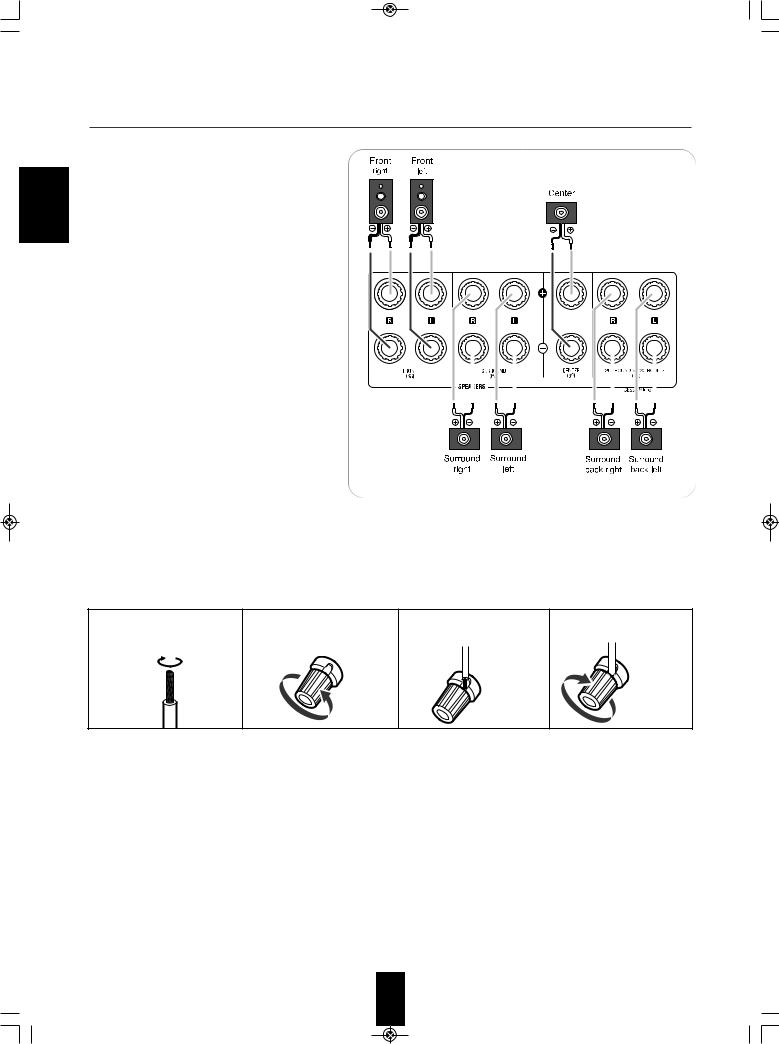
 R-904N(A)_ENG_091007:R-904N(A) 2009-10-14 1:53
R-904N(A)_ENG_091007:R-904N(A) 2009-10-14 1:53  8
8
ENGLISH
6. CONNECTING SPEAkERS
• Be sure to connect speakers firmly and correctly according to the channel(left and right) and the polarity (+ and -). If the connections are faulty, no sound will be heard from the speakers, and if the polarity of the speaker connection is incorrect, the sound will be unnatural and lack bass.
• When using only one surround back speaker, you should connect it to SURROUND BACK/ ROOM2 LEFT channel.
•Because this receiver cannot drive the surround back speakers and the ROOM2 speakers
simultaneously, you should assign their power amplifier correctly depending on how to use them. (For details, refer to "CONNECTING ROOM2 SPEAKERS" on page 9 and "When selecting the AMP ASSIGN" on page 48.)
• For installing the speakers, refer to "Speaker placement" on page 9.
• After installing the speakers, first adjust the speaker settings according to your environment and speaker layout. (For details, refer to "SETTING THE ROOM EQ" on page 49.)
Caution :
• Be sure to use the speakers with the impedance of 6 ohms or above.
•Do not let the bare speaker wires touch each other or any metal part of this unit. This could damage this unit and/or the speakers.
•Never touch the speaker terminals while the AC input cord is connected to the wall AC outlet. Doing so could result in electric shocks.
■Connecting speaker wire |
|
|
|
1. Strip away approx. 10 mm |
2. Loosen by turning the |
3. Insert the bare part of the |
4. Tighten by turning it |
(3/8 inch) of wire insulation, |
speaker terminal counter- |
wire. |
clockwise. |
then twist the wire ends |
clockwise. |
|
|
tight. |
|
|
|
8
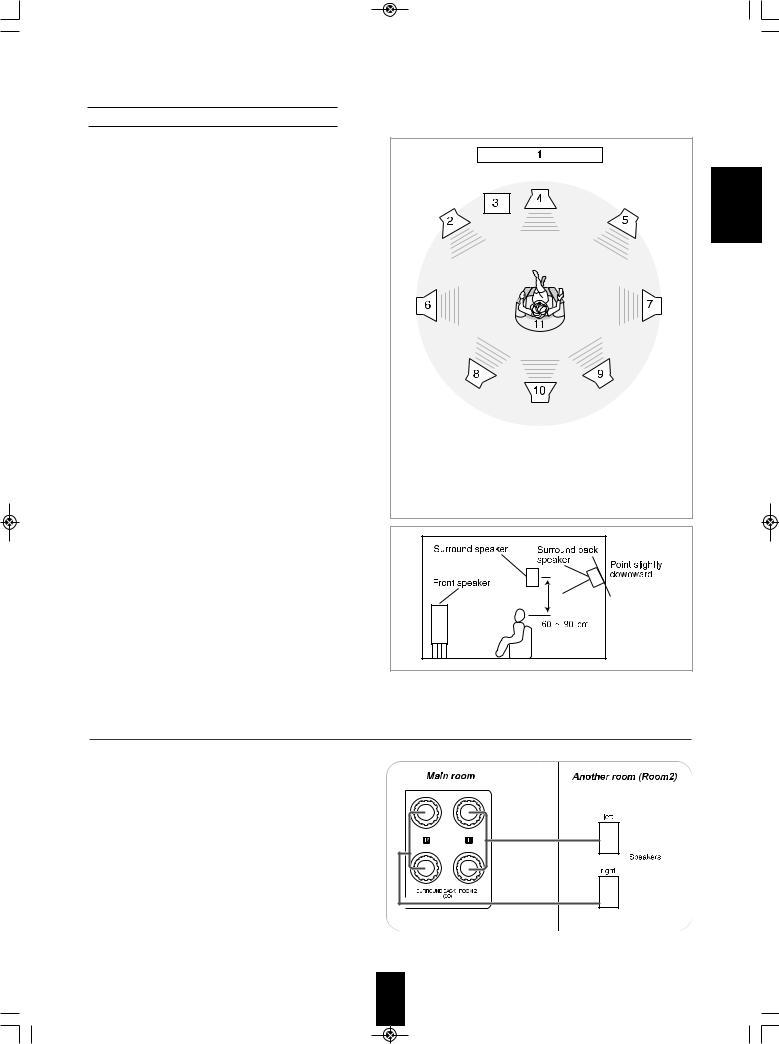
 R-904N(A)_ENG_091007:R-904N(A) 2009-10-14 1:53
R-904N(A)_ENG_091007:R-904N(A) 2009-10-14 1:53  9
9
Speaker placement
Ideal speaker placement varies depending on the size of your room and the wall coverings, etc. The typical example of speaker placement and recommendations are as follows :
■Front left and right speakers and center speaker
•Place the front speakers with their front surfaces as flush with TV or monitor screen as possible.
•Place the center speaker between the front left and right speakers and no further from the listening position than the front speakers.
•Place each speaker so that sound is aimed at the location of the listener’s ears when at the main listening position.
■Surround left and right speakers
•Place the surround speakers approximately 1 meter (40 inches) above the ear level of a seated listener on the direct left and right of them or slightly behind.
■Surround back left and right speakers
•Place the surround back speakers at the back facing the front at a narrower distance than front speakers.
•When using a single surround back speaker, place it at the rear center facing the front at a slightly higher position (0 to 20 cm ) than the surround speakers.
•We recommend installing the surround back speaker(s) at a slightly downward facing angle. This effectively prevents the surround back channel signals from reflecting off the
TV or screen at the front center, resulting in interference and making the sense of movement from the front to the back less sharp.
■Subwoofer
•The subwoofer reproduces powerful deep bass sounds. Place a subwoofer anywhere in the front as desired.
■Notes :
•When using a conventional TV, to avoid interference with the TV picture, use only magnetically shielded front
left and right and center speakers.
•To obtain the best surround effects, the speakers except the subwoofer should be full range speakers.
|
|
|
|
ENGLISH |
1. |
TV or Screen |
7. |
Surround right speaker |
|
2. |
Front left speaker |
8. |
Surround back left speaker |
|
3. |
Subwoofer |
9. |
Surround back right speaker |
|
4. |
Center speaker |
10. |
Surround center speaker |
|
5. |
Front right speaker |
11. |
Listening position |
|
6. |
Surround left speaker |
|
|
|
7. CONNECTING ROOM2 SPEAkERS
•ROOM2 playback feature allows you to play a different program source in another room as well as one source in the main room at the same time.
•For ROOM2 playback, connect the ROOM2 speakers to the SURROUND BACK/ROOM2 terminals.
•Because this receiver cannot drive the surround back speakers and the ROOM2 speakers simultaneously, you should assign their power amplifier correctly depending on how to use them. (For details, refer to “When selecting the AMP ASSIGN” on page 48.)
9

 R-904N(A)_ENG_091007:R-904N(A) 2009-10-14 1:53
R-904N(A)_ENG_091007:R-904N(A) 2009-10-14 1:53  10
10
ENGLISH
8. CONNECTING FOR SYSTEM CONTROL
• Connect this jack to the DIGILINK-i jack of Sherwood iPod dock that allows you to control the iPod with the unit's remote control.
9. CONNECTING TO NETWORk
When you connect this receiver to a home network, you can enjoy viewing a variety of video contents and listening to internet radio audio that the built-in VuNow Pod delivers via broadband without the use of a personal computer (PC).
• There are two ways to connect to a home network as illustrated below :
■Wired Connection
• Connect the LAN connector of this receiver to your internet source.
LAN
Internet |
Modem |
Broadband router |
PC |
■Wireless Connection
•Connect the supplied VuNow USB Wireless adapter to the USB connector and install a broadband router supporting wireless LAN.
•The USB memory device can be also connected to the USB connector to play video or music files, etc. or to download the rented videos. (For details on connecting USB memory device, refer to “USB CONNECTOR” on page 12.)
■Notes :
•Be sure to make either wired connection or wireless connection. (You don’t need to do both.)
•After making a broadband internet connection, you should set the communication setting. (For details, refer to “Network” on page 42.)
•When using a broadband internet connection, a contract with an internet service provider is required. For more information, contact your nearest internet service provider.
•Refer to the operating instructions of the equipment because the connected equipment and connection method may differ depending on your internet environment.
•Use a LAN cable/router supporting 10 BASE-T/100 BASE-TX.
•A broadband speed of 768 kbps or more is recommended.
•Some LAN cables are easily affected by noise. We recommend using a shielded type cable.
10. AC INPUT CORD
• Plug this cord into a wall AC outlet.
10
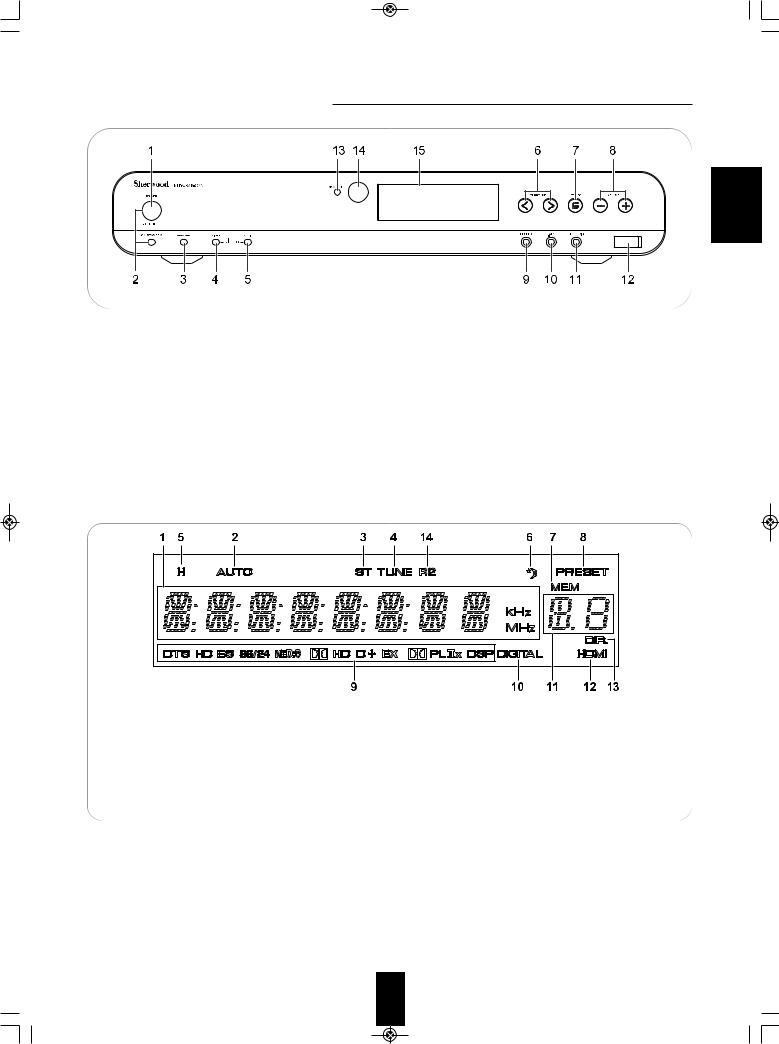
 R-904N(A)_ENG_091007:R-904N(A) 2009-10-14 1:53
R-904N(A)_ENG_091007:R-904N(A) 2009-10-14 1:53  11
11
Front Panel Controls
ENGLISH
1. POWER switch |
10. F. AUX jack |
2. POWER ON/STANDBY button/indicator |
For details, see next page. |
3. SPEAKER button |
11. SETUP MIC jack |
4. VIDEO INPUT SELECTOR button |
For details, see next page. |
5. AUDIO INPUT SELECTOR button |
12. USB connector |
6. SURROUND MODE UP/DOWN( / ) buttons |
For details, see next page |
7. STEREO button |
13. DOLBY VOLUME indicator |
8. VOLUME UP/DOWN (+/-) buttons |
14. REMOTE SENSOR |
9. HEADPHONE jack |
15. FLUORESCENT DISPLAY |
|
For details, see below. |
■FLUORESCENT DISPLAY
1. |
Input, frequency, volume level, operating information, etc. |
8. |
PRESET indicator |
2. |
AUTO indicator |
9. |
Surround mode indicators |
3. |
STEREO indicator |
10. |
DIGITAL indicator |
4. |
TUNED indicator |
11. |
Preset number, sleep time display |
5. |
HEADPHONE indicator |
12. |
HDMI indicator |
6. |
SLEEP indicator |
13. |
DIRECT indicator |
7. |
MEMORY indicator |
14. |
ROOM2 indicator |
11
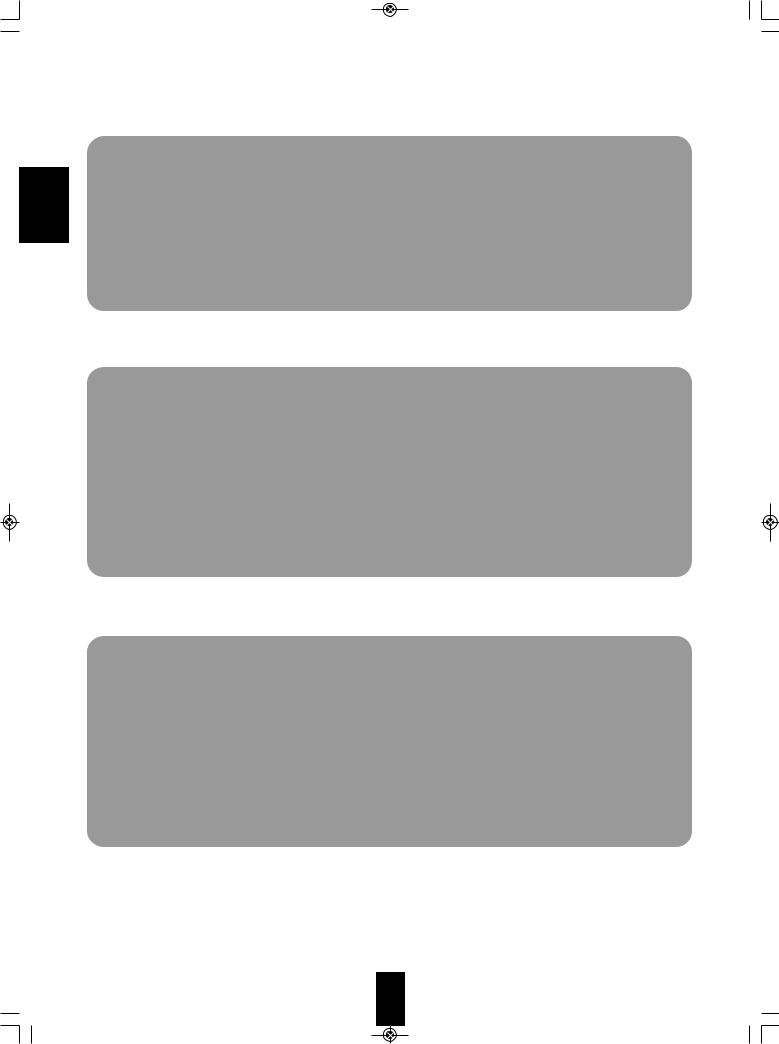
 R-904N(A)_ENG_091007:R-904N(A) 2009-10-14 1:53
R-904N(A)_ENG_091007:R-904N(A) 2009-10-14 1:53  12
12
ENGLISH
■ FRONT AUx JACk
• The FRONT AUX jack can be connected to additional audio components such as an MP3 player, etc.
■Note :
• When connecting this jack to an MP3 player, etc., you should use the stereo mini cord, not a mono mini cord.
■ SETUP MIC JACk
•To use Room EQ setup function, connect the supplied microphone to the SETUP MIC jack. (For details, refer to
“SETTING THE ROOM EQ” on page 49.)
■Notes:
•Because the microphone for Room EQ setup is designed for use with this receiver, do not use a microphone other than the one supplied with this receiver.
•After you have completed the Room EQ setup procedure, disconnect the microphone.
■USB CONNECTOR
•This connector can be connected to a USB memory device to play video or music files, etc. or to download the rented videos from VuNow service. (For details, refer to “ENJOYING
INTERNET VIDEOS” on page 31.)
•The supplied VuNow USB wireless adapter can be also connected to the USB connector for broadband internet connection. (For details on connecting the supplied VuNow USB wireless adapter, refer to “CONNECTING TO NETWORK” on page 10.)
■Notes:
•Before connecting a USB memory device, open the cover.
•Do not use a USB extension cable when connecting a USB memory device to this connector.
•After playing files or downloading the rented videos, remove the USB memory device performing “Eject USB Disk” procedure on page 34.)
12
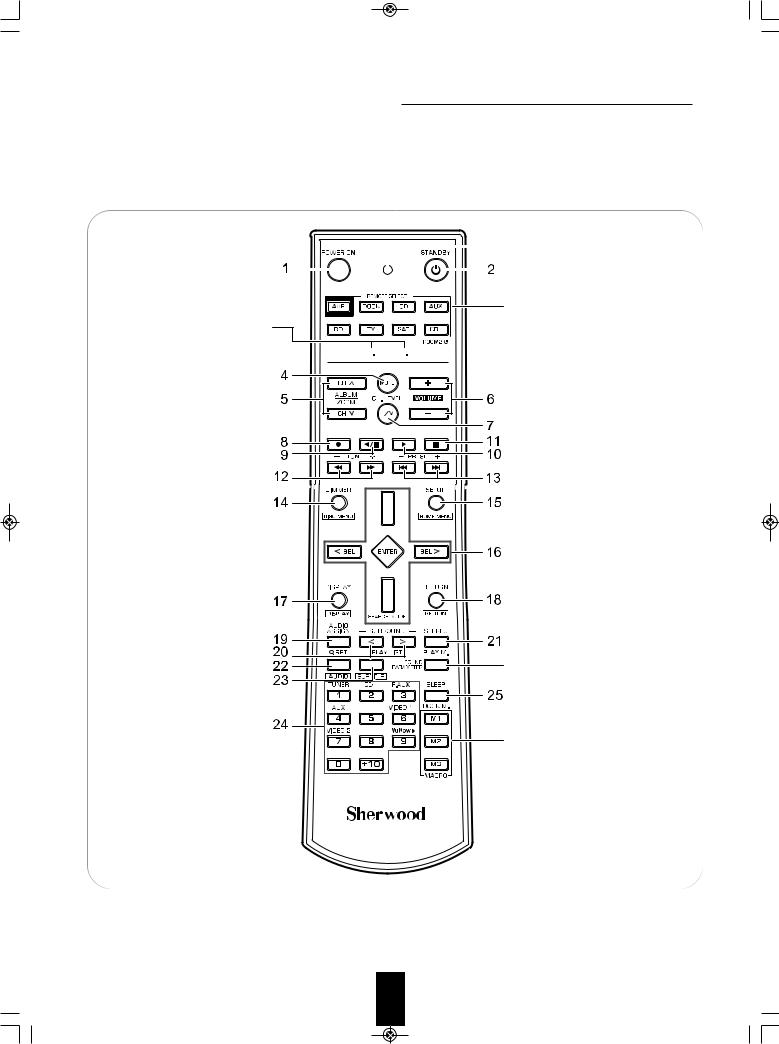
 R-904N(A)_ENG_091007:R-904N(A) 2009-10-14 1:53
R-904N(A)_ENG_091007:R-904N(A) 2009-10-14 1:53  13
13
Universal Remote Controls
This universal remote control can operate not only this receiver but also most popular brands of audio and video components such as iPod docks, CD players, tape decks, TVs, BD/DVD players, satellite receivers, cable boxes, etc.
• To operate 7 components other than this receiver, you should enter the setup code for each component. |
|
||||||||
(For details, refer to “USING FUNCTIONS OF REMOTE CONTROL” on page 16.) |
|
|
|||||||
• The numbered buttons on the remote control have different functions in different device modes. For details, refer to |
ENGLISH |
||||||||
“FUNCTION TABLE of the NUMBERED BUTTONS” on the next page. |
|
||||||||
|
|
||||||||
POWER ON button |
|
|
|
|
|
|
|
LED |
|
|
|
|
|
|
|
|
|
||
|
|
|
|
|
|
|
|
||
|
|
|
|
|
|
|
STANDBY button |
|
|
|
|
|
|
|
|
|
|
|
|
DEVICE buttons
ROOM2 VOLUME UP/DOWN( / ) buttons
ROOM2 INPUT 






SELECTOR buttons MUTE button
To operate the desired component with this remote control, first select the corresponding DEVICE button.
ROOM2 button
VOLUME UP/DOWN(+/-) buttons
TUNING UP/DOWN(+/-) buttons |
PRESET UP/DOWN(+/-) buttons |
|
DIMMER button |
SETUP button |
|
|
CURSOR CONTROL, ENTER |
|
|
buttons |
|
DISPLAY button |
RETURN button |
|
AUDIO ASSIGN button |
STEREO button |
|
SURROUND MODE |
||
|
||
UP/DOWN ( / ) buttons |
SOUND PARAMETER button |
|
NUMERIC (0~9, +10)/ |
SLEEP button |
|
|
||
INPUT SELECTOR buttons |
|
|
To select the desired input |
MACRO(M1~M3) buttons |
source of TUNER~VuNow |
To operate a macro function, |
|
|
|
press the corresponding |
|
MACRO button. |
13
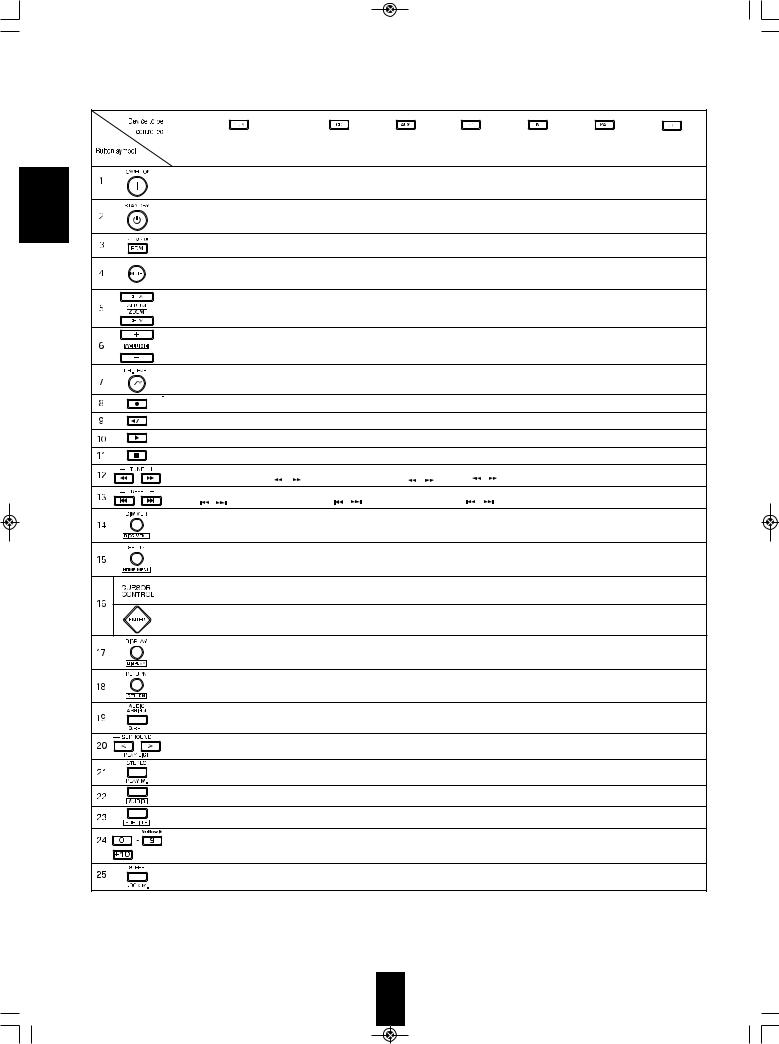
 R-904N(A)_ENG_091007:R-904N(A) 2009-10-14 1:53
R-904N(A)_ENG_091007:R-904N(A) 2009-10-14 1:53  14
14
■FUNCTION TABLE of the NUMBERED BUTTONS.
ENGLISH
■Notes :
|
|
|
|
|
|
|
|
|
|
(for CD player) |
|
|
|
|
|
|
|
|
|
|
|
|
|
|
|
|
|
|
|
|
|
|
|||||
|
|
|
|
|
|
|
|
|
|
|
|
|
|
|
|
|
|
|
|
|
|
|
|
|
|
|
|
|
|
|
|
||||||
|
|
|
|
|
|
|
|
|
|
|
|
|
|
|
|
|
|
|
|
|
|
|
|
|
|
|
|
|
|
|
|
||||||
|
|
|
|
(for iPod Dock) |
(for VCR) |
(for Tape deck) |
(for BD/DVD |
(for TV) |
(for Satellite |
(for Cable box) |
|||||||||||||||||||||||||||
|
|
|
|
|
|
|
|
|
|
|
|
|
|
|
|
|
|
|
|
|
|
|
player) |
|
|
|
|
receiver) |
|
|
|
||||||
|
|
|
|
|
|
|
POWER |
POWER |
|
|
|
|
|
|
|
|
POWER |
|
POWER |
POWER |
POWER |
||||||||||||||||
|
|
|
|
|
|
|
|
ON |
|
|
ON |
|
|
|
|
|
|
|
|
|
|
ON |
|
ON |
ON |
|
ON |
||||||||||
|
|
|
|
|
|
|
STANDBY |
STANDBY |
|
|
|
|
|
|
|
|
STANDBY |
|
STANDBY |
STANDBY |
STANDBY |
||||||||||||||||
|
|
|
|
|
|
|
|
|
|
|
|
|
|
|
|
||||||||||||||||||||||
|
|
|
|
|
|
|
(POWER OFF) |
(POWER OFF) |
|
|
|
|
|
|
|
(POWER OFF) |
(POWER OFF) |
(POWER OFF) |
(POWER OFF) |
||||||||||||||||||
|
|
|
|
RANDOM |
|
|
|
|
|
|
|
|
|
|
|
|
|
|
|
|
|
|
|
|
|
|
|
|
|
|
|
|
|
|
|
||
|
|
|
|
|
|
|
|
|
|
|
|
|
|
|
|
|
|
|
|
|
|
|
|
|
|
|
|
|
|
|
|
|
|
|
|||
|
|
|
|
MUTE |
|
|
|
|
|
|
|
|
|
|
|
|
|
|
|
|
|
|
|
MUTE |
MUTE |
MUTE |
|||||||||||
|
|
|
|
|
|
|
|
|
|
|
|
|
|
|
|
|
|
|
|
|
|
|
|
|
|
||||||||||||
|
|
|
|
|
|
|
|
|
|
|
|
|
|
|
|
|
|
|
|
|
|
|
|
|
|
||||||||||||
|
|
|
|
ALBUM |
CHANNEL |
|
|
|
|
|
|
|
|
|
|
|
|
|
|
|
|
|
|
|
CHANNEL |
CHANNEL |
CHANNEL |
||||||||||
|
|
|
|
UP/DOWN |
UP/DOWN |
|
|
|
|
|
|
|
|
|
|
|
|
|
|
|
|
|
|
|
UP/DOWN |
UP/DOWN |
UP/DOWN |
||||||||||
|
|
|
|
|
|
|
|
|
|
|
|
|
|
|
|
|
|
|
|
|
|
|
|||||||||||||||
|
|
|
|
(/ ) |
(/ ) |
|
|
|
|
|
|
|
|
|
|
|
|
|
|
|
|
|
|
|
(/ ) |
(/ ) |
/ ) |
||||||||||
|
|
|
|
|
|
|
|
|
|
|
|
|
|
|
|
|
|
|
|
|
|
|
|
|
|
|
|
|
|
|
|
( |
|
|
|||
|
|
|
|
|
|
|
VOLUME |
|
|
|
|
|
|
|
|
|
|
|
|
|
|
|
|
|
|
|
VOLUME |
VOLUME |
VOLUME |
||||||||
|
|
|
|
|
|
|
UP/DOWN (+/-) |
|
|
|
|
|
|
|
|
|
|
|
|
|
|
|
|
|
|
|
UP/DOWN (+/-) |
UP/DOWN (+/-) |
UP/DOWN (+/-) |
||||||||
|
|
|
|
|
|
|
|
|
|
|
|
|
|
|
|
|
|
|
|
|
|
|
|
|
|
||||||||||||
|
|
|
|
|
|
|
INPUT |
|
|
|
|
|
|
|
|
|
|
|
|
|
INPUT |
|
INPUT |
INPUT |
INPUT |
||||||||||||
|
|
|
|
|
|
|
SELECTOR |
|
|
|
|
|
|
|
|
|
|
|
|
|
SELECTOR |
SELECTOR |
SELECTOR |
SELECTOR |
|||||||||||||
|
|
|
|
|
|
|
|
|
|
|
|
|
|
|
|
|
|
|
|
||||||||||||||||||
|
|
|
|
|
|
|
|
|
|
|
|
|
|
|
|
|
|
|
|
||||||||||||||||||
|
|
|
|
|
|
|
RECORD |
|
|
|
|
|
|
RECORD |
|
|
|
|
|
|
|
|
|
|
|
|
|
|
|
||||||||
|
|
|
|
|
|
|
PAUSE |
|
|
|
|
|
|
|
|
|
|
|
|
|
|
|
|
||||||||||||||
|
|
|
|
|
|
|
PAUSE |
|
PAUSE |
PAUSE |
|
|
|
|
|
|
|
|
|
|
|||||||||||||||||
|
|
|
|
PLAY/PAUSE |
PLAY |
PLAY |
|
PLAY |
PLAY |
|
|
|
|
|
|
|
|
|
|
||||||||||||||||||
|
|
|
|
|
|
|
|
|
|
|
|
|
|
|
|||||||||||||||||||||||
|
|
|
|
|
|
|
|
|
|
|
|
|
|
|
|||||||||||||||||||||||
|
|
|
|
|
|
|
|
|
|
|
|
|
|
|
|||||||||||||||||||||||
|
|
|
|
|
|
|
STOP |
STOP |
|
STOP |
STOP |
|
|
|
|
|
|
|
|
|
|
||||||||||||||||
|
|
|
|
|
|
|
|
|
|
|
|
|
|
|
|
|
|
||||||||||||||||||||
|
|
|
|
|
|
|
|
|
|
|
|
|
|
|
|
|
|
||||||||||||||||||||
|
|
|
|
|
|
|
REWIND/FAST |
|
|
|
|
|
|
REWIND /FAST |
REVERSE/FORWARD |
|
|
|
|
|
|
|
|
|
|||||||||||||
|
|
|
|
|
|
|
FORWARD( / ) |
REVERSE/FORWARD |
FORWARD( / ) |
SEARCH( |
/ |
) |
|
|
|
|
|
|
|
|
|
||||||||||||||||
|
|
|
|
|
|
|
|
|
|
|
|
|
|
|
|
||||||||||||||||||||||
|
|
|
|
REVERSE/FORWARD |
|
|
|
|
|
|
|
|
|
|
REVERSE/FORWARD |
|
|
|
|
|
|
|
|
|
|||||||||||||
|
|
|
|
SKIP( / ) |
|
|
|
SKIP( / |
) |
|
|
|
|
|
|
|
SKIP( |
/ |
|
) |
|
|
|
|
|
|
|
|
|
||||||||
|
|
|
|
|
|
|
|
|
|
|
|
|
|
|
|
|
|
|
|
|
|
|
|
||||||||||||||
|
|
|
|
|
|
|
|
|
|
|
|
|
|
|
|
|
|
|
|
|
|
|
|||||||||||||||
|
|
|
|
MENU |
|
|
|
|
|
|
|
|
|
|
|
|
|
|
|
|
DISC MENU |
|
|
|
|
|
|
|
|
|
|||||||
|
|
|
|
|
|
|
|
|
|
|
|
|
|
|
|
|
|
|
|
|
|
|
|
|
|
|
|
|
|||||||||
|
|
|
|
|
|
|
|
|
|
|
|
|
|
|
|
|
|
|
|
|
|
|
|
|
|
|
|
|
|||||||||
|
|
|
|
|
|
|
|
|
|
|
|
|
|
|
|
|
|
|
|
|
|
|
|
|
|
|
|
|
|||||||||
|
|
|
|
|
|
|
|
|
|
|
|
|
|
|
|
|
|
|
|
|
|
|
|
|
|
|
|
|
|||||||||
|
|
|
|
|
|
|
|
|
|
|
|
|
|
|
|
|
|
|
|
|
|
|
HOME MENU |
|
|
|
|
|
|
|
|
|
|||||
|
|
|
|
|
|
|
|
|
|
|
|
|
|
|
|
|
|
|
|
|
|
|
|
|
|
|
|
|
|
|
|
||||||
|
|
|
|
|
|
|
|
|
|
|
|
|
|
|
|
|
|
|
|
|
|
|
|
|
|
|
|
|
|
|
|
||||||
|
|
|
|
CURSOR |
|
|
|
|
|
|
|
|
|
|
|
|
|
|
|
|
CURSOR |
|
|
|
|
|
|
|
|
|
|
||||||
|
|
|
|
|
|
|
|
|
|
|
|
|
|
|
|
|
|
|
|
|
|
|
|
|
|
|
|
|
|
||||||||
|
|
|
|
|
|
|
|
|
|
|
|
|
|
|
|
|
|
|
|
|
|
|
|
|
|
|
|
|
|
||||||||
|
|
|
|
|
|
|
|
|
|
|
|
|
|
|
|
|
|
|
|
UP/DOWN |
|
|
|
|
|
|
|
|
|
|
|||||||
|
|
|
|
UP/DOWN |
|
|
|
|
|
|
|
|
|
|
|
|
|
|
|
|
|
|
|
|
|
|
|
|
|
|
|||||||
|
|
|
|
|
|
|
|
|
|
|
|
|
|
|
|
|
|
|
|
|
|
|
|
|
|
|
|
|
|
|
|
|
|
|
|||
|
|
|
|
ENTER |
|
|
|
|
|
|
|
|
|
|
|
|
|
|
|
|
ENTER |
|
|
|
|
|
|
|
|
|
|
||||||
|
|
|
|
|
|
|
|
|
|
|
|
|
|
|
|
|
|
|
|
|
|
|
|
|
|
|
|
|
|
||||||||
|
|
|
|
|
|
|
|
|
|
|
|
|
|
|
|
|
|
|
|
|
|
|
|
|
|
|
|
|
|
||||||||
|
|
|
|
|
|
|
|
|
|
|
|
|
|
|
|
|
|
|
|
|
|
|
|
|
|
|
|
|
|
||||||||
|
|
|
|
|
|
|
|
|
|
|
|
|
|
|
|
|
|
|
|
|
|
|
|
|
|
|
|
|
|
|
|
|
|
|
|||
|
|
|
|
|
|
|
|
|
|
|
|
|
|
|
|
|
|
|
|
|
|
|
DISPLAY |
|
|
|
|
|
|
|
|
|
|
||||
|
|
|
|
|
|
|
|
|
|
|
|
|
|
|
|
|
|
|
|
|
|
|
|
|
|
|
|
|
|
|
|
|
|||||
|
|
|
|
|
|
|
|
|
|
|
|
|
|
|
|
|
|
|
|
|
|
|
|
|
|
|
|
|
|
|
|
|
|||||
|
|
|
|
|
|
|
|
|
|
|
|
|
|
|
|
|
|
|
|
|
|
|
RETURN |
|
|
|
|
|
|
|
|
|
|
||||
|
|
|
|
|
|
|
|
|
|
|
|
|
|
|
|
|
|
|
|
|
|
|
|
|
|
|
|
|
|
|
|
|
|||||
|
|
|
|
REPEAT |
|
|
|
|
|
|
|
|
|
|
|
|
|
|
|
|
REPEAT |
|
|
|
|
|
|
|
|
|
|
||||||
|
|
|
|
|
|
|
|
|
|
|
|
|
|
|
|
|
|
|
|
|
|
|
|
|
|
|
|
|
|
||||||||
|
|
|
|
|
|
|
|
|
|
|
|
|
|
|
|
|
|
|
|
|
|
|
|
|
|
|
|
|
|
||||||||
|
|
|
|
|
|
|
|
|
|
|
|
|
|
|
|
|
|
|
|
|
|
|
|
|
|
|
|
|
|
||||||||
|
|
|
|
|
|
|
|
|
|
|
|
|
|
|
|
|
|
|
|
|
|
|
|
|
|
|
|
|
|
||||||||
|
|
|
|
|
|
|
|
|
|
|
|
|
|
|
|
|
|
|
|
|
|
|
|
|
|
|
|
|
|
|
|
|
|
|
|||
|
|
|
|
PLAY LIST |
|
|
|
|
|
|
|
|
|
|
|
|
|
|
|
|
PLAY LIST |
|
|
|
|
|
|
|
|
|
|
||||||
|
|
|
|
|
|
|
|
|
|
|
|
|
|
|
|
|
|
|
|
|
|
|
|
|
|
|
|
|
|
||||||||
|
|
|
|
|
|
|
|
|
|
|
|
|
|
|
|
|
|
|
|
|
|
|
|
|
|
|
|
|
|
||||||||
|
|
|
|
UP/DOWN(>/<) |
|
|
|
|
|
|
|
|
|
|
|
|
|
|
|
|
UP/DOWN(>/<) |
|
|
|
|
|
|
|
|
|
|
||||||
|
|
|
|
|
|
|
|
|
|
|
|
|
|
|
|
|
|
|
|
|
|
|
|
|
|
|
|
|
|
||||||||
|
|
|
|
|
|
|
|
|
|
|
|
|
|
|
|
|
|
|
|
|
|
|
|
|
|
|
|
|
|
||||||||
|
|
|
|
|
|
|
|
|
|
|
|
|
|
|
|
|
|
|
|
|
|
|
PLAY MODE |
|
|
|
|
|
|
|
|
|
|||||
|
|
|
|
|
|
|
|
|
|
|
|
|
|
|
|
|
|
|
|
|
|
|
|
|
|
|
|
|
|
|
|
||||||
|
|
|
|
|
|
|
|
|
|
|
|
|
|
|
|
|
|
|
|
|
|
|
|
|
|
|
|
|
|
|
|
||||||
|
|
|
|
|
|
|
|
|
|
|
|
|
|
|
|
|
|
|
|
|
|
|
AUDIO |
|
|
|
|
|
|
|
|
|
|
||||
|
|
|
|
|
|
|
|
|
|
|
|
|
|
|
|
|
|
|
|
|
|
|
|
|
|
|
|
|
|
|
|
|
|||||
|
|
|
|
|
|
|
|
|
|
|
|
|
|
|
|
|
|
|
|
|
|
|
SUBTITLE |
|
|
|
|
|
|
|
|
|
|
||||
|
|
|
|
|
|
|
NUMERIC |
NUMERIC |
|
|
|
|
|
|
|
|
|
|
|
|
|
|
|
|
|
|
|||||||||||
|
|
|
|
|
|
|
|
|
|
|
|
|
|
|
NUMERIC |
|
NUMERIC |
NUMERIC |
NUMERIC |
||||||||||||||||||
|
|
|
|
|
|
|
|
|
|
|
|
|
|
|
|
||||||||||||||||||||||
|
|
|
|
DOCK MODE |
|
|
|
|
|
|
|
|
|
||||||||||||||||||||||||
|
|
|
|
|
|
|
|
|
|
|
|
|
|
|
|
|
|
|
|
|
|
|
|
|
|
|
|
|
|
|
|
|
|
|
|||
|
|
|
|
|
|
|
|
|
|
|
|
|
|
|
|
|
|
|
|
|
|
|
|
|
|
|
|
|
|
|
|
|
|
|
|||
|
|
|
|
|
|
|
|
|
|
|
|
|
|
|
|
|
|
|
|
|
|
|
|
|
|
|
|
|
|
|
|
|
|
|
|
|
|
•Some functions for each component may not be available or may work differently.
•Depending on other kinds of components that are available for each DEVICE button, some functions may not be available or may work differently, too.
•For details about functions, refer to the operating instructions of each component.
14
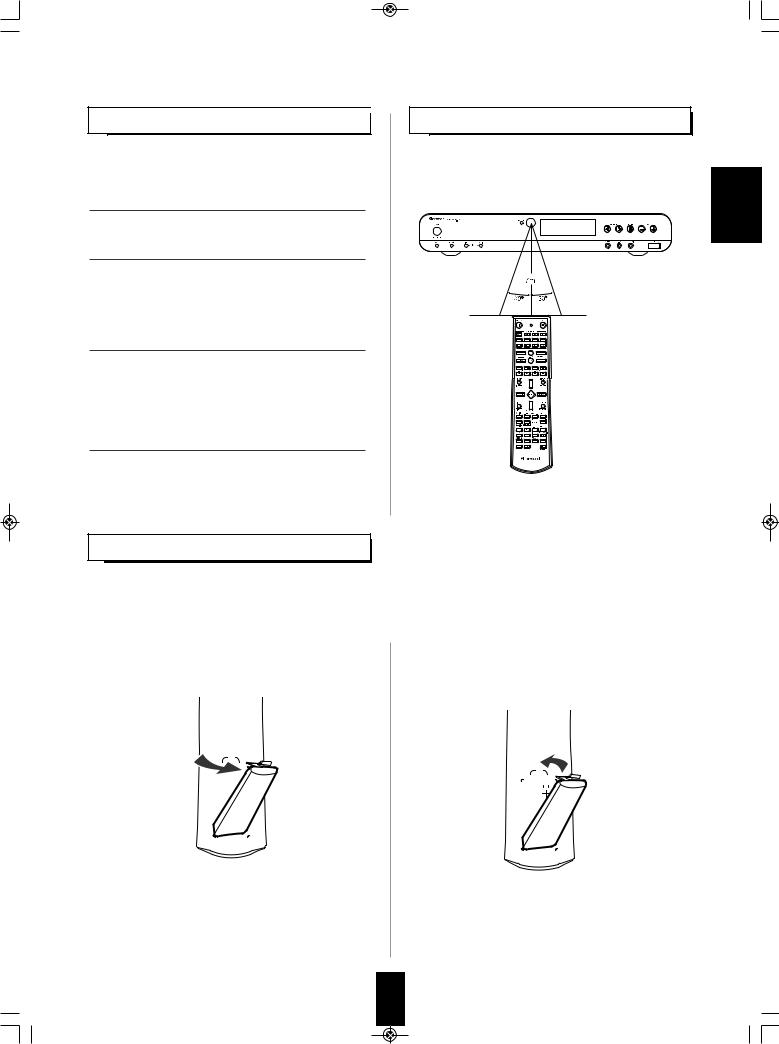
 R-904N(A)_ENG_091007:R-904N(A) 2009-10-14 1:53
R-904N(A)_ENG_091007:R-904N(A) 2009-10-14 1:53  15
15
oPeRAtInG coMPonentsWItH ReMote contRoL 
1. Enter the setup code for each component other
than this receiver. For details, refer to “Entering a setup code” on page 16.
2. Turn on the component you want to operate.
3. Press the DEVICE button on the remote control
corresponding to the component you wish to operate.
4. Aim the remote control at the REMOTE
SENSOR of the component you wish to control and press the button corresponding to the operation you want.
•In such a case that some components do not have the REMOTE SENSOR which receives the remote signals, this remote control cannot operate them.
LoADInG BAtteRIes
ReMote contRoL oPeRAtIon RAnGe
•Use the remote control within a range of about 7 meters (23 feet) and angles of up to 30 degrees aiming at the remote sensor.
•When the remote control does not operate, the old batteries should be replaced. In this case, load new batteries within several minutes after removing old batteries.
•If the batteries are removed or have been exhausted for a longer period of time, memorized contents will be cleared. Should this happen, you should memorize them again.
1. Remove the cover. |
|
|
|
|
|
2. Load two batteries (“AAA” size, 1.5V) matching |
|||||||||||||||||||||||||||
|
|
|
|
|
|
|
|
|
|
|
|
|
|
|
|
the polarity. |
|||||||||||||||||
|
|
|
|
|
|
|
|
|
|
|
|
|
|
|
|||||||||||||||||||
|
|
|
|
|
|
|
|
|
|
|
|
|
|
|
|
|
|
|
|
|
|
|
|
|
|
|
|
|
|
|
|
|
|
|
|
|
|
|
|
|
|
|
|
|
|
|
|
|
|
|
|
|
|
|
|
|
|
|
|
|
|
|
|
|
|
|
|
|
|
|
|
|
|
|
|
|
|
|
|
|
|
|
|
|
|
|
|
|
|
|
|
|
|
|
|
|
|
|
|
|
|
|
|
|
|
|
|
|
|
|
|
|
|
|
|
|
|
|
|
|
|
|
|
|
|
|
|
|
|
|
|
|
|
|
|
|
|
|
|
|
|
|
|
|
|
|
|
|
|
|
|
|
|
|
|
|
|
|
|
|
|
|
|
|
|
|
|
|
|
|
|
|
|
|
|
|
|
|
|
|
|
|
|
|
|
|
|
|
|
|
|
|
|
|
|
|
|
|
|
|
|
|
|
|
|
|
|
|
|
|
|
|
|
|
|
|
|
|
|
|
|
|
|
|
|
|
|
|
|
|
|
|
|
|
|
|
|
|
|
|
|
|
|
|
|
|
|
|
|
|
|
|
|
|
|
|
|
|
|
|
|
|
|
|
|
|
|
|
|
|
|
|
|
|
|
|
|
|
|
|
|
|
|
|
|
|
|
|
|
|
|
|
|
|
|
|
|
|
|
|
|
|
|
|
|
|
|
|
|
|
|
|
|
|
|
|
|
|
|
|
|
|
|
|
|
|
|
|
|
|
|
|
|
|
|
|
|
|
|
|
|
|
|
|
|
|
|
|
|
|
|
|
|
|
|
|
|
|
|
|
|
|
|
|
|
|
|
|
|
|
|
|
|
|
|
|
|
|
|
|
|
|
|
|
|
|
|
|
|
|
|
|
|
|
|
|
|
|
|
|
|
|
|
|
|
|
|
• Remove the batteries when they are not used for a long time.
• Do not use the rechargeable batteries (Ni-Cd type).
• Be sure to use alkaline batteries.
ENGLISH
15
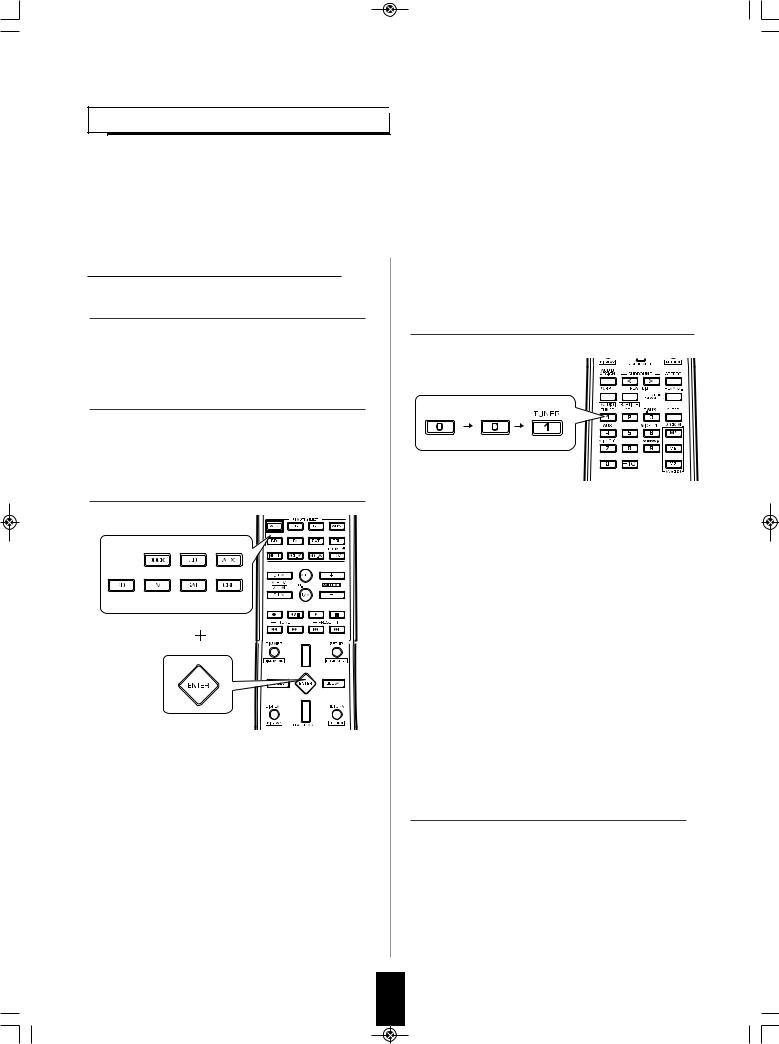
 R-904N(A)_ENG_091007:R-904N(A) 2009-10-14 1:53
R-904N(A)_ENG_091007:R-904N(A) 2009-10-14 1:53  16
16
UsInG FUnctIons oF ReMote contRoL 
|
|
• This remote control can control up to 8 different components. |
|
|
|
• Before operating audio and video components other than this receiver with using this remote control, the setup code for each |
|
ENGLISH |
|
component should be entered. |
|
|
• For system remote control operation, “000” was stored previously in the memory of the device button “DOCK” for Sherwood iPod |
||
|
|
||
|
|
dock, “CD” for Sherwood CD player, “BD” for Sherwood BD/DVD player and “TV” for Sherwood TV respectively as its factory |
|
|
|
setup code. So, you don’t need to enter its code for each Sherwood component except in such a case that its code does not work. |
|
|
|
|
|
|
|
|
|
Entering a setup code |
|
1. Turn on the component you want to operate. |
4. Enter a 3 digit code, aiming the remote control at |
|
the remote sensor on the component. |
2. Find the setup codes according to the type and |
Example: When entering “001”. |
|
|
the brand name of your component, referring to |
|
“Setup Code Table” on page 57. |
|
3. Press and hold down both the ENTER button |
|
and the desired one of the DEVICE buttons for |
|
more than 1 seconds. |
|
|
• If entering is performed successfully, the LED will flicker |
|
twice. |
|
• To be sure that the setup code is correct, press the |
|
POWER ON (or STANDBY) button. If your component |
|
is turned off, the setup code is correct. |
|
• When your component is not turned off, repeat the |
|
above steps 2 to 4, trying each code for your |
|
component until you find one that works. |
|
■Notes: |
|
• If the LED did not flicker twice, then repeat the above |
|
steps 3 to 4 and try entering the same code again. |
|
• Manufacturers may use different setup codes for the |
|
same product category. For that reason, it is important |
|
that you check to see if the code you have entered |
|
operates as many controls as possible. If only a few |
|
functions operate, check to see if another code will work |
• The LED will flicker once. |
with more buttons. |
|
|
■Note : |
5. Repeat the above steps 1 to 4 for each of your |
• The “AVR” button is unavailable for the audio |
|
components other than this receiver. |
components. |
|
16
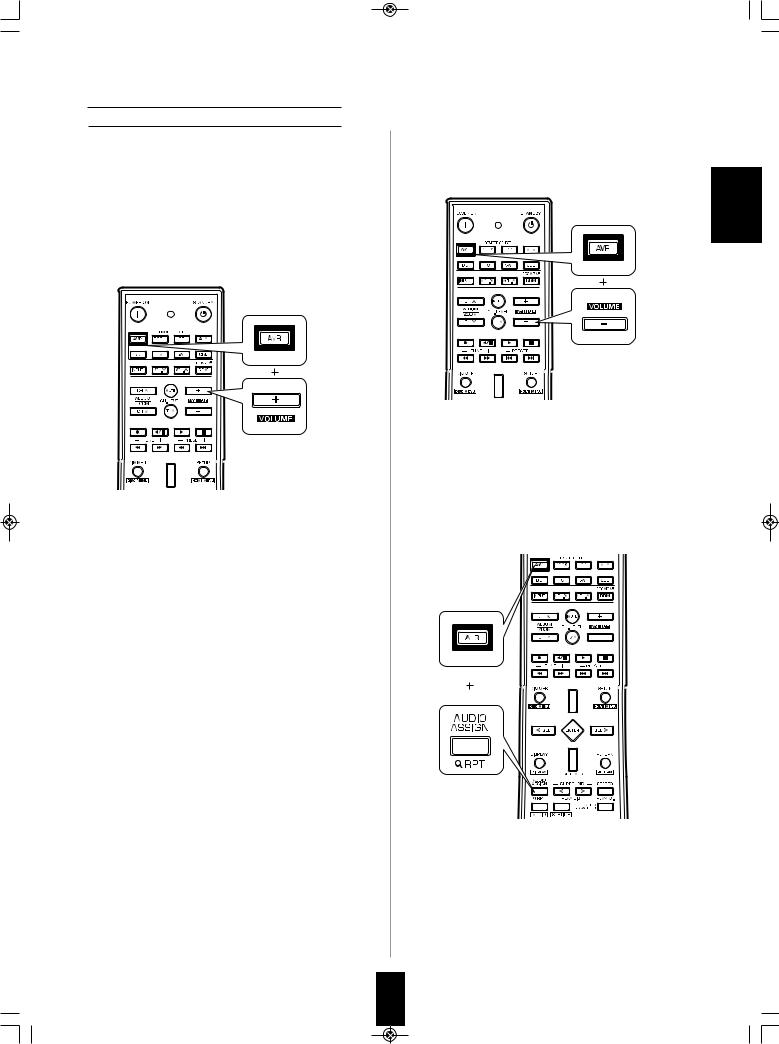
 R-904N(A)_ENG_091007:R-904N(A) 2009-10-14 1:53
R-904N(A)_ENG_091007:R-904N(A) 2009-10-14 1:53  17
17
Using a punch-through function
This remote control may be programmed to operate either the AUDIO volume punch-through or the TV volume and/or
TV channel punch-through in conjunction with any of the 8 components controlled by this remote control.
For example, since this receiver will likely be used as the sound system while watching TV, you may want to adjust this receiver’s volume although this remote control is set to control the TV.
•When programming this remote control for the AUDIO volume punch-through, press and hold down both “AVR” button and “VOLUME +” button for more than 1 second.
•If programming is performed successfully, the SET LED will flicker twice.
•When you want either TV volume or TV channel punch-through, press and hold down both “TV” button and either “VOLUME +” or “CH ” button for more than 1 second.
■Note :
•If you use one of AUDIO and TV volume punchthrough functions, you cannot use the other.
■Removing a punch-through function
•When removing the AUDIO volume punch-through, press and hold down both “AVR” button and “VOLUME -” button for more than 1 second.
•If removing is performed successfully, the LED will flicker twice.
•When you want to remove either TV volume or TV channel punch-through, press and hold down both “TV” button and either “VOLUME -” or “CH ” button for more than 1 second.
■Removing all punch-through functions
Press and hold down both “AVR” button and “AUDIO
ASSIGN” button for more than 1 second.
•If removing all punch-through functions is performed successfully, the LED will flicker twice.
ENGLISH
17
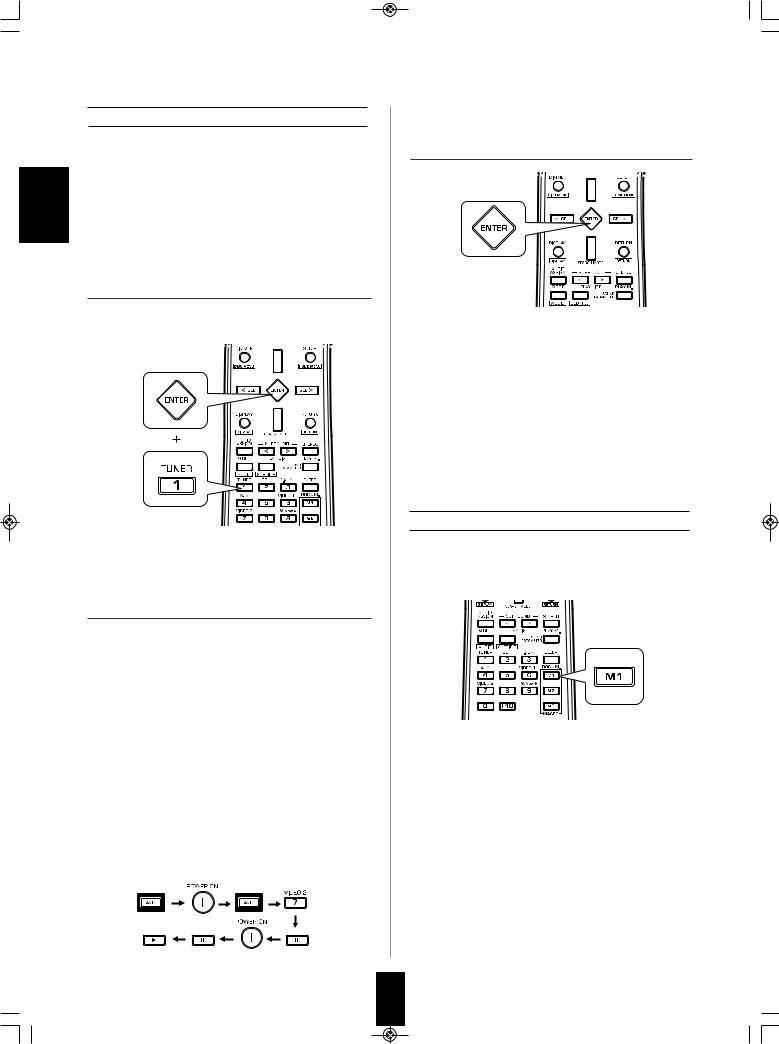
 R-904N(A)_ENG_091007:R-904N(A) 2009-10-14 1:53
R-904N(A)_ENG_091007:R-904N(A) 2009-10-14 1:53  18
18
ENGLISH
Programming a macro function
•The macro function enables you to program a series of button operations(up to 10) on this remote control into a single button.
•You can store up to three separate macro command sequences into “M1”, “M2” and “M3” buttons.
1.Press and hold down both “ENTER” button and one of three NUMERIC buttons (“1” ~ “3”) corresponding to “M1”~”M3” buttons for more than 1 second.
Example: When programming a series of button operations into “M1” button.
•If the macro mode is entered, the LED will flicker once.
2. Press the operation buttons you want to program in order.
■Note :
You should press the corresponding DEVICE buttons before pressing each operation button.
Example: When playing a BD on the BD player connected to VIDEO 2 jacks of this receiver.
. Press “AVR” button to control this receiver.. Press “POWER ON” button to turn this
receiver on.
. Press “AVR” button to control this receiver.. Press “VIDEO 2(7)” button to select the
desired input source.
. Press “BD” button to control the BD player.. Press “POWER ON” button to turn the BD
player on.
. Press “BD” button to control the BD player.. Press “ ” button to start playback.
3. Press “ENTER” button.
•If the programming is performed successfully, the LED will flicker twice.
■To remove a macro program
•When removing a macro program, perform the above steps 1 and 3, but ignore the step 2.
■To change a macro program
•When a new macro program is stored into a MACRO button with performing the above steps 1 to 3, the previous macro program is cleared from the memory of the MACRO button.
Operating a macro function
•Aim the remote control at the REMOTE SENSORs of the components to be controlled and press the MACRO button you want.
Example: When pressing “M1” button.
■Notes:
•The codes programmed into a MACRO button will be transmitted at an interval of 0.5 seconds. However, some components may not be able to complete one operation in 0.5 seconds and may miss the next code.
In this case, the macro function cannot control the corresponding components correctly.
•Be sure to use the remote control within the remote control operation range of the components.
•Depending on the operation status of the components, etc., the macro function cannot control the corresponding components correctly.
18

 R-904N(A)_ENG_091007:R-904N(A) 2009-10-14 1:53
R-904N(A)_ENG_091007:R-904N(A) 2009-10-14 1:53  19
19
Operations
■Notes:
•Before operating this receiver with the supplied remote control, refer to “Universal Remote Controls” on page 13 for details about operation.
•Before operating this receiver, first set this unit as desired for optimum performance, doing the system setup procedures.
(For details, refer to “System Setup” on page 46.)
LISTENING TO A PROGRAM SOURCE
Before operation
•Enter the standby mode.
•The POWER ON/STANDBY indicator lights up amber. This means that the receiver is not disconnected from the AC mains and a small amount of current is retained to support the operation readiness.
•To switch the power off, push the POWER switch again.
Then the power is cut off and the POWER ON/STANDBY indicator goes off.
1. In the standby mode, turn the power on.
•Each time the POWER ON/STANDBY button on the front panel is pressed, the receiver is turned on to enter the operating mode (the POWER ON/STANDBY indicator lights up blue) or off to enter the standby mode (the POWER ON/STANDBY indicator lights up amber).
•On the remote control, press the POWER ON button to enter the operating mode or press the STANDBY button to enter the standby mode.
2. Switch the speakers on.
•Then “SPK ON” is displayed for several seconds and the sound can be heard from the speakers connected to the speaker terminals.
•When using the headphones for private listening, press the SPEAKER button again to switch the speakers off. Then
“SPK OFF” is displayed for several seconds (“H” indicator lights up.)
3. Select the desired input source.
•Each time the “VIDEO” on the front panel is pressed, the
input source changes as follows: → VIDEO 1 → V2/IPOD → VuNow
•Each time the “AUDIO” button is pressed, the input source changes as follows:
→ TUNER → CD → AUX → F.AUX 
(Frequency display)
•Each time the “TUNER” button on the remote control is
pressed, the band changes as follows: → FM ST → FM MONO
•To enjoy VuNow, refer to “ENJOYING INTERNET VIDEOS” on page 31.
■Note:
•When the VuNow is selected, depending on whether the HDMI MONITOR OUT is connected or not, the video signals are automatically output from either the HDMI MONITOR OUT (given priority) or the (composite) VIDEO
MONITOR OUT only.
ENGLISH
19
